Papers by Kostas Kalabokidis
Computers & Geosciences, 2009
As the demand for geospatial data increases, the lack of efficient ways to find suitable informat... more As the demand for geospatial data increases, the lack of efficient ways to find suitable information becomes critical. In this paper, a new methodology for knowledge discovery in geographic portals is presented. Based on the Semantic Web, our approach exploits the Resource Description Framework (RDF) in order to describe the geoportal's information with ontology-based metadata. When users traverse from page to page in the portal, they take advantage of the metadata infrastructure to navigate easily through data of interest. New metadata descriptions are published in the geoportal according to the RDF schemas.
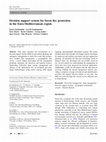
European Journal of Forest Research, 2012
This paper describes the development of a decision support system (DSS) for prevention planning a... more This paper describes the development of a decision support system (DSS) for prevention planning and emergency management of forest fire events that incorporates weather data management, a geographical data viewer, a priori danger forecasting and fire propagation modeling, automatic fire detection, and optimal resource dispatching. Collection, input, storage, management, and analysis of the information rely on advanced and automated methodologies using remote sensing, GPS, digital mapping, and geographic information systems. The results included short-term dynamic fire danger indices developed for improved and realistic prevention and pre-suppression planning. An automatic fire detection technology based on infrared video was developed and successfully tested on site. Several models for understanding fire propagation on forest fires have been proposed for practical application. Additionally, a DSS was developed with the innovation of covering wildland fire hazard management entirely, providing a complete coverage of technical and administrative activities that support decision makers in real time. The DSS was tested for high fire seasons in two different sites in South Europe.
The focus of our study is to assess fire risk zones using historical wildland fire ignition obser... more The focus of our study is to assess fire risk zones using historical wildland fire ignition observations recorded between 1985 and 2004. Kernel density estimation, a non parametric statistical method for estimating probability densities, has been widely used for home range estimation in wildlife ecology. It has the advantage of directly producing density estimates that are not influenced by grid
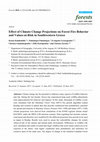
Forests, 2015
Climate change has the potential to influence many aspects of wildfire behavior and risk. During ... more Climate change has the potential to influence many aspects of wildfire behavior and risk. During the last decade, Greece has experienced large-scale wildfire phenomena with unprecedented fire behavior and impacts. In this study, thousands of wildfire events were simulated with the Minimum Travel Time (MTT) fire growth algorithm (called Randig) and resulted in spatial data that describe conditional burn probabilities, potential fire spread and intensity in Messinia, Greece. Present (1961 and future (2071-2100) climate projections were derived from simulations of the KNMI regional climate model RACMO2, under the SRES A1B emission scenario. Data regarding fuel moisture content, wind speed and direction were modified for the different projection time periods to be used as inputs in Randig. Results were used to assess the vulnerability changes for certain values-at-risk of the natural and human-made environment. Differences in wildfire risk were calculated and results revealed that larger wildfires that resist initial control are to be expected in the future, with higher conditional burn probabilities and intensities for extensive parts of the study area. The degree of change in the modeled Canadian Forest

Advances in Engineering Software, 2015
ABSTRACT This paper proposes a novel training algorithm for radial basis function neural networks... more ABSTRACT This paper proposes a novel training algorithm for radial basis function neural networks based on fuzzy clustering and particle swarm optimization. So far, fuzzy clustering has proven to be a very efficient tool in designing such kind of networks. The motivation of the current work is to quantify the exact effect of fuzzy cluster analysis on the network's performance and use it in order to substantially improve this per-formance. There are two key theoretical findings resulting from the present work. First, it is analytically proved that when the standard fuzzy c-means algorithm is used to generate the input space fuzzy parti-tion, the main effect this partition imposes to the network's square error (i.e. performance index) can be written down in terms of a distortion function that measures the ability of the partition to recreate the original data. Second, using the aforementioned distortion function, an upper bound of the network's square error can be constructed. Then, the particle swarm optimization (PSO) is put in place to minimize the above upper bound and determine the network's parameters. To further improve the accuracy, the basis function widths and the connection weights are fine-tuned by employing a steepest descent approach. The main experimental findings are: (a) the implementation of the PSO obtains a significant reduction of the square error while exhibiting a smooth dynamic behavior, (b) although the steepest des-cent further decreases the error it finally obtains smaller reduction rates, meaning that the strongest impact on the error reduction is provided by the PSO, and (c) the improved performance of the proposed network is demonstrated through an extensive comparison with other related methods using a 10-fold cross-validation analysis.

Advances in forest fire research, 2014
Fire management systems materialize the integration of fire science models and decision support p... more Fire management systems materialize the integration of fire science models and decision support planning modules. Their operational usage often requires the concurrent execution of a large number of fire growth simulations by multiple users. Intensive computations such as the creation of burn probability maps demand not only high expertise but also high computing power and data storage capacity. The purpose of this paper is to present some of the initial results of the AEGIS platform, which is a Web-GIS wildfire prevention and management information system currently under development. More specifically, the paper focuses on the utilization of the Minimum Travel Time (MTT) algorithm as a powerful fire behavior prediction system. MTT in AEGIS will be applied in a transparent way through its graphical user interface. Several end users will be able to conduct on-demand fire behavior simulations. To achieve this, end users must provide a minimum amount of inputs, such as fire duration, ignition point and weather information. Weather inputs can be either inserted directly or derived from selected remote automatic weather stations or forecasted weather data maps based on the SKIRON system (Eta/NCEP model). Seasonal burn probability maps will be also prepared and provided to the end users. Socioeconomic data, weather predictions, topographic and vegetation data will be combined with artificial neural networks to produce an ignition probability map. Based on the ignition probability map, thousands of potential ignition points located in areas of anticipated high risk will be generated. These ignitions will be further used as inputs on MTT simulations, running FConstMTT as a command line-based executable. FConstMTT calculations will be conducted on a parallel mode in Microsoft Azure infrastructure using a different subset of ignition points in each simulation. The current deployment of the AEGIS platform consists of a number of machines resided on premises and a scalable Cloud Computing environment based on the Microsoft Azure infrastructure. This parallel computing environment ensures high processing power availability and high data storage capacity. During a fire emergency, the scalability of the Cloud can also provide extra processing power and storage, if needed. It is anticipated that by integrating MTT into the AEGIS platform, the firefighting and civil protection agencies will gain great assistance to organize better and more reliable plans for fire confrontation.

Restoration of Mediterranean-type forest ecosystems is of great importance and a main environment... more Restoration of Mediterranean-type forest ecosystems is of great importance and a main environmental issue in Greece and other countries of the Mediterranean basin as well. For the effective implementation of proper restoration practices, a thorough knowledge is required as regards post-fire regeneration processes, namely changes that occur in the vegetation composition and the evolution of ecosystem resilience rate, after one or more fire incidents. The research work presented in the paper, took place at the National Park of Sounio (Greece), where an intensive forest land survey was performed. Forest-ecosystem resilience and vegetation composition was studied under various post-fire regimes by the use of Remote Sensing and GIS techniques. For that purpose, Landsat (TM and ETM+) satellite images spanning a 20-year period were used for the calculation of NDVI time-series. Classification maps depicting the pre- and post-fire situation were also considered. Results showed that for the s...

Natural Resource Modeling, 2008
Based on kernel density estimation methods, this paper introduces an alternative approach of fire... more Based on kernel density estimation methods, this paper introduces an alternative approach of fire occurrence modeling that addresses the inherent positional inaccuracies of recorded wildland fire ignition points. These observations, recorded in longitude and latitude using only degrees and first minutes, contain positional inaccuracies of about ±700 to ±925 meters in x and y axes. Kernel density estimation was applied to these historical fire observations recorded between 1985 and 1995 in Halkidiki peninsula, Greece, as well as, to simulated inaccurate points into which positional inaccuracies of the same magnitude were randomly introduced. Substantial differences were observed when a regular grid of quadrants was superimposed over the two point distributions. Although, at higher grid resolution these mismatches were minimized, the problem of generalization appeared. Contrarily, the concept of "moving window" assisted to retain high grid resolution and minimize the effect of inaccurate point observations. In addition, the kernel approach, which considers also the relative position of points within the "moving window," produced more realistic estimates.

Natural Hazards, 2009
Artificial neural networks (ANNs) show a significant ability to discover patterns in data that ar... more Artificial neural networks (ANNs) show a significant ability to discover patterns in data that are too obscure to go through standard statistical methods. Data of natural phenomena usually exhibit significantly unpredictable non-linearity, but the robust behavior of a neural network makes it perfectly adaptable to environmental models such as a wildland fire danger rating system. These systems have been adopted by many developed countries that have invested in wildland fire prevention, and thus civil protection agencies are able to identify areas with high probabilities of fire ignition and resort to necessary actions. Since one of the drawbacks of ANNs is the interpretation of the final model in terms of the importance of variables, this article presents the results of sensitivity analysis performed in a back-propagation neural network (BPN) to distinguish the influence of each variable in a fire ignition risk scheme developed for Lesvos Island in Greece. Four different methods were utilized to evaluate the three fire danger indices developed within the above scheme; three of the methods are based on network's weights after the training procedure (i.e., the percentage of influence-PI, the weight product-WP, and the partial derivatives-PD methods), and one is based on the logistic regression (LR) model between BPN inputs and observed outputs. Results showed that the occurrence of rainfall, the 10-h fuel moisture content, and the month of the year parameter are the most significant variables of the Fire Weather, Fire Hazard, and Fire Risk Indices, respectively. Relative humidity, elevation, and day of the week have a small contribution to fire ignitions in the study area. The PD method showed the best performance in ranking variables' importance, while performance of the rest of the methods was influenced by the number of input parameters and the magnitude of their importance. The results can be used by local forest managers and other decision makers dealing with wildland fires to take the appropriate preventive measures by emphasizing on the important factors of fire occurrence.
Journal of Maps, 2014
ABSTRACT
Journal of Environmental Policy & Planning, 2011
... b , Kostas Kalabokidis c & Theodoros Iosifides c pages 349-371. ... Kalabokidis, KD a... more ... b , Kostas Kalabokidis c & Theodoros Iosifides c pages 349-371. ... Kalabokidis, KD and Stamou, N. Analysis and planning for forest fire management in the Aegean. Proceedings of the 7th National Forestry Conference . October 11–13 1995 , Karditsa, Greece. pp.558–567. ...
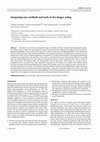
International Journal of Wildland Fire, 2007
Prevention is one of the most important stages in wildfire and other natural hazard management re... more Prevention is one of the most important stages in wildfire and other natural hazard management regimes. Fire danger rating systems have been adopted by many developed countries dealing with wildfire prevention and presuppression planning, so that civil protection agencies are able to define areas with high probabilities of fire ignition and resort to necessary actions. This present paper presents a fire ignition risk scheme, developed in the study area of Lesvos Island, Greece, that can be an integral component of a quantitative Fire Danger Rating System. The proposed methodology estimates the geo-spatial fire risk regardless of fire causes or expected burned area, and it has the ability of forecasting based on meteorological data. The main output of the proposed scheme is the Fire Ignition Index, which is based on three other indices: Fire Weather Index, Fire Hazard Index, and Fire Risk Index. These indices are not just a relative probability for fire occurrence, but a rather quantitative assessment of fire danger in a systematic way. Remote sensing data from the high-resolution QuickBird and the Landsat ETM satellite sensors were utilised in order to provide part of the input parameters to the scheme, while Remote Automatic Weather Stations and the SKIRON/Eta weather forecasting system provided real-time and forecasted meteorological data, respectively. Geographic Information Systems were used for management and spatial analyses of the input parameters. The relationship between wildfire occurrence and the input parameters was investigated by neural networks whose training was based on historical data.

International Journal of Remote Sensing, 2013
ABSTRACT This study aims at quantifying and mapping fire-related characteristics of forest struct... more ABSTRACT This study aims at quantifying and mapping fire-related characteristics of forest structure through field inventories, statistics, remote sensing, and geographical information systems in the island of Lesvos, northeast Aegean Sea, Greece. Simulation of fire behaviour requires forest biomass inputs that describe surface fuel types/models along with canopy fuel properties, such as canopy cover, stand height, crown base height, and crown bulk density, to accurately predict surface and crown fire spread and spotting potential. Forest canopy characteristics and other vegetation attributes were sampled and derived in over 100 field plots, the majority of which were located in coastal pine forest stands. Regression models involving four dependent forest stand variables (stand height, canopy cover, crown base height, and crown bulk density) were developed using generalized additive models. The values of adjusted R 2 were 0.72 for stand height, 0.68 for canopy cover, 0.51 for crown base height, and 0.33 for crown bulk density. These regression models were used to create forest fuel characteristics layers, which can be used as inputs to fire management applications and state-of-the-art landscape-scale fire behaviour models.
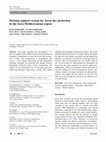
European Journal of Forest Research, 2012
This paper describes the development of a decision support system (DSS) for prevention planning a... more This paper describes the development of a decision support system (DSS) for prevention planning and emergency management of forest fire events that incorporates weather data management, a geographical data viewer, a priori danger forecasting and fire propagation modeling, automatic fire detection, and optimal resource dispatching. Collection, input, storage, management, and analysis of the information rely on advanced and automated methodologies using remote sensing, GPS, digital mapping, and geographic information systems. The results included short-term dynamic fire danger indices developed for improved and realistic prevention and pre-suppression planning. An automatic fire detection technology based on infrared video was developed and successfully tested on site. Several models for understanding fire propagation on forest fires have been proposed for practical application. Additionally, a DSS was developed with the innovation of covering wildland fire hazard management entirely, providing a complete coverage of technical and administrative activities that support decision makers in real time. The DSS was tested for high fire seasons in two different sites in South Europe.
Environmental Science & Policy, 2008
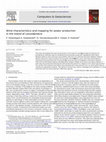
Computers & Geosciences, 2011
This study investigated the wind characteristics of the island of Lesvos, Greece, with the object... more This study investigated the wind characteristics of the island of Lesvos, Greece, with the objective of providing the necessary data for identifying the wind power production capabilities of the island. Weather patterns were examined using weather data from four Remote Automatic Weather Stations. Specific tools were used to produce the necessary windroses, Weibull curves and charts that helped to understand the prevailing wind characteristics. By using the tools of Geographic Information Systems (GIS) and the Wind Atlas Analysis and Application Program (WAsP) as the basic calculation platform, a wind map was produced portraying the wind speeds that prevail at a height of 10 m above ground level. The results of the analysis were tested and evaluated with measurements from 15 wind turbine sites by creating six alternative scenarios. The optimum scenario was used to investigate the installation of a small wind farm with five wind turbines, of 3 MW total capacity.
Proceedings of the …, 2002
ABSTRACT: Fire, weather and vegetation patterns are key elements of the natural environment viewe... more ABSTRACT: Fire, weather and vegetation patterns are key elements of the natural environment viewed in human perspective. Knowledge of the causes that configure the structure and spatial distribution of vegetation is the cornerstone in sustainable development, especially in ...
Area, 2007
This paper focuses on spatial distribution of long-term fire patterns versus physical and anthrop... more This paper focuses on spatial distribution of long-term fire patterns versus physical and anthropogenic elements of the environment that determine wildfire dynamics in Greece. Logistic regression and correspondence analysis were applied in a spatial database that had been ...
Human Ecology …, 2005
This paper compares Greek and American social experi-ence of wildfire management. Regional compar... more This paper compares Greek and American social experi-ence of wildfire management. Regional comparison of the two countries' experience with wildfire reveals a common thread of experience and management regimes. Efforts to control the risk of fire damage over time have ...
European Journal of Forest Research, 2011
Empirical allometric equations relating biomass of aboveground components to dendrometric variabl... more Empirical allometric equations relating biomass of aboveground components to dendrometric variables for Pinus brutia Ten. trees are derived in this paper.
Uploads
Papers by Kostas Kalabokidis